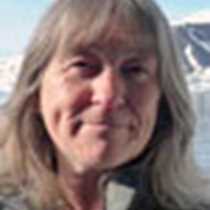Tempelfjorden and Billefjornden, West Spitsbergen
Mountains produce many responses in the onlooker. We may see geological strata, climbing routes or human faces in the rock. When the scientifically-minded N.C. Dunér and A.E Nordenskiöld came this way in the 1860s and looked on the 770-metre-high mountain towering over the waters of the fjord, they saw a giant, crumbling pillared Gothic cathedral, and called it “Templet.”
At the head of Tempelfjorden (an offshoot of Isfjorden, penetrating deep into the interior of Spitsbergen) is a majestic glacier front, formed of two glaciers joined together with a great streak of medial moraine. The very active Tunabreen Glacier has its source in the high interior, 23 km to the north, while the Von Postbreen Glacier grinds its way from the east. This formed a glorious backdrop for our morning activities of kayaking and Zodiac cruising among the floating ice dotted with fulmars, and kittiwakes hungrily thronging at the glacier face, and the occasional ethereal ivory gull, watched by a bearded seal hauled out on an ice floe.
After lunch a most unusual experience awaited us. For days we have explored the pristine wilderness, the ice-white home of the polar bear with its immaculate sea-ice, glaciers and ice-caps. Now we returned to a human landscape, providing the greatest contrast imaginable. Near the head of Billefjorden, another offshoot of Isfjorden, stands a mountain shaped like a pyramid. Within it lie black seams of coal amongst the Carboniferous sandstones laid down about 350 million years ago.
This was first investigated by Swedish prospectors in 1910, but since 1926 Pyramiden has been in Russian hands. A coal-mining community became established, swelling to a settlement of about 1000 people in the 1970s and 80s until suddenly, in 1998, the mine and the entire town was abandoned. Everything was left apparently just as it was, a remarkable time capsule from the Soviet era.
It was eerie to wander among the empty buildings - accommodation blocks, school and kindergarten, farm buildings, swimming pool, culture house, and monuments— the farthest north example of all these things in the world, overseen now by just a skeleton staff, and all dominated by the huge Nordenskiöld Glacier in the background. Extensive consignments of bricks, ready for further building works, lay just as they were left. Musical instruments lay abandoned in the Culture House.
We looked at the decaying industrial infrastructure with its muddy stream wash, and words like ‘bleak’ and ‘desolate’ came to our western minds. Outside all was detritus from the mines, but inside, people had lovingly created beautiful ornamental woodwork and paintwork everywhere. And it was with touching enthusiasm that the young Russian guide Dmitri, with glittering eyes, described for us the life of the community there, the talented nature of the workforce, the activities and facilities they enjoyed together, and how glad they had been to be part of Pyramiden.
Travel throws up such unexpected moments. Arctic Svalbard showed us its wildlife and natural beauty to a breathtaking extent. Now we have seen another side, the human story of an Arctic Russian mining town, a memorial of a bygone age frozen in time, poised between the life it knew, and an uncertain destiny. What will the future hold for it, and for the Arctic?




